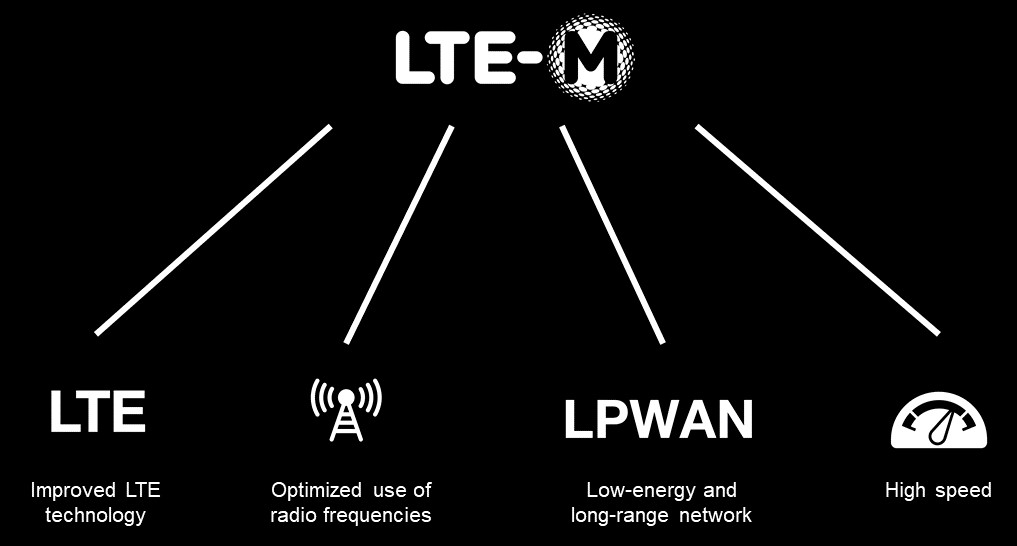What is the difference between LTE and LTE-M?
LTE and LTE-M are two technologies that could be described as mother and daughter. In a nutshell, LTE is 4G and LTE-M is 4G optimized for connected objects that need to be highly mobile or consume less energy.
Here are our explanations and some examples of applications.
Contents:
-
The difference between LTE and LTE-M
-
LTE: definition and applications
-
LTE-M: definition and applications
-
When to choose LTE-M?
-
When to choose LTE or LTE-M?
1. The difference between LTE and LTE-M
There is a major difference between LTE and LTE-M.
 |
This technology enables connected object manufacturers to transfer data over long distances, while minimizing energy consumption. LTE-M covers many use cases with high speeds and a large volume of data. It is essential for many IoT solutions. |
LTE-M is an offshoot of LTE technology that has been optimized for the Internet of Things; the M refers to Machine to Machine.
2. LTE: definition and applications
LTE (Long Term Evolution) – the term refers to the evolution from 1G to 4G – is the fourth generation of (wireless) cellular standard for all mobile communications. LTE is made up of an architecture, radio frequencies, performances, and uses that create high speeds, low latency, quick downloads, etc.
What is more, the network has a theoretical peak download speed of up to 326.4 Mbps and a theoretical peak upload speed of up to 86.4 Mbps. Five categories of LTE device have been defined. All of them are compatible with the frequency bands between 1.4 and 20 MHz.
3. Définition et applications du LTE-M
LTE-M is a cellular network dedicated to the IoT, with technology that has been standardised by 3GPP. Orange has marketed this LTE network option since the end of 2018.
LTE-M has many advantages:
- Optimised energy management for objects, thanks to standby phases that extend battery life and so reduce maintenance costs.
- Better radio coverage, extended by + 8 dBm, which is useful for indoor and deep indoor uses. It can pass through an additional thick wall for example.
- Excellent mobility: an LTE-M connected device on the move can switch from cell to cell (area of cover) without signal loss. The handover (moving from one antenna to the next) is imperceptible.
- Finally, internationally, objects benefit from the simplicity of roaming on the LTE cell network, with additional energy saving functions: PSM and eDRX.
4. When to choose LTE-M?
In a challenge developed in partnership with SNCF, Orange demonstrated the importance and relevance of LTE-M for the IoT. The aim of the challenge was to verify the promises made by LTE-M technology.
The main focus was train stations: the goal was to improve the quality of life for workers and travellers in order to better secure the location and optimize maintenance.
As the network spokesperson at SNCF said in an interview with Hello Future: “The IoT is used in a reasonable and reasoned way, and offers us greater agility by enabling us, for example, to access places where we have not previously had sufficient coverage in terms of energy and connectivity. It is a real game-changer, and will help to modernize our processes through new sensors and innovation in wireless technologies, whether relating to energy or connectivity.”
In concrete terms, the Challenge explored several use cases including:
- Protecting SNCF workers in stations: LTE-M solves signal loss issues inside buildings
- Detecting people or animals in a tunnel: LTE-M makes it easier to perform checks
- Monitoring lighting in train tunnels, etc.
5. When to choose LTE or LTE-M?
LTE-M is a development of LTE technology, optimized for connected objects, that is the best solution to lower energy consumption, increase signal range and reduce equipment costs.
LTE is more appropriate for applications requiring higher speeds.